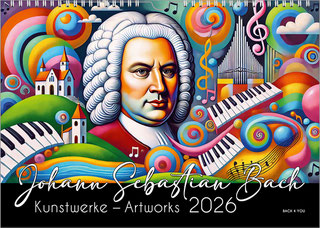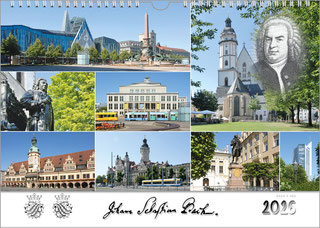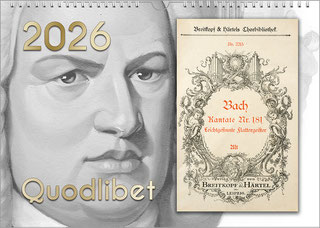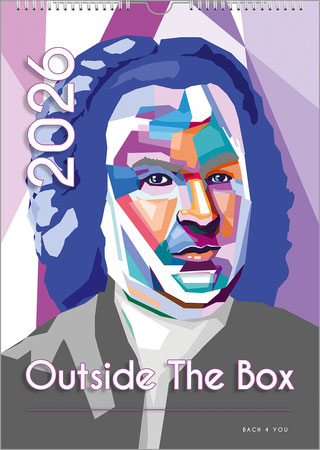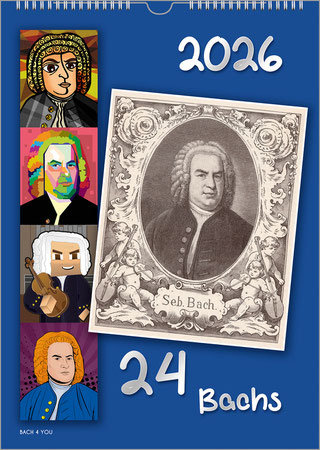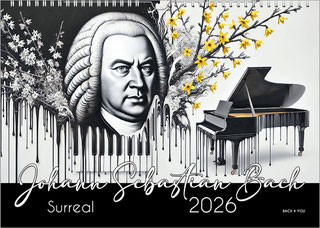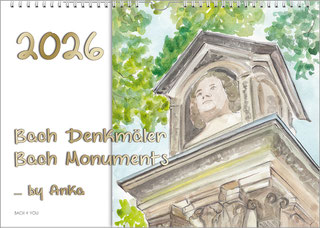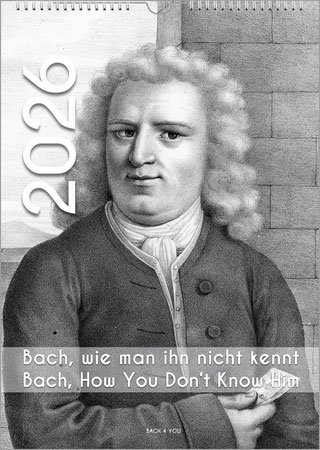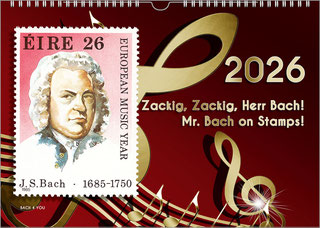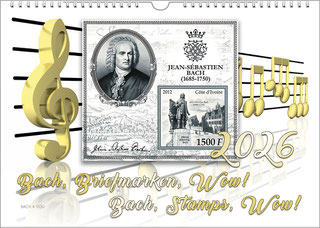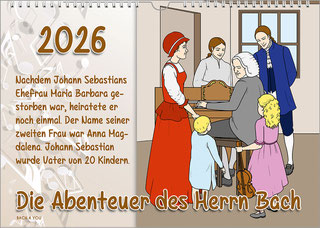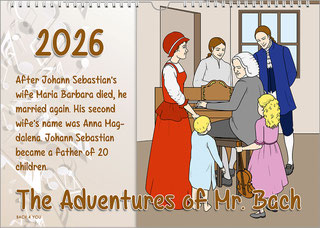Bach Calendars: 2 Value Priced + 18 Print on Demand
The Value Priced Bach Wall Calendar
DIN A4 – € 13.90*
DIN A3 – € 19.90*
DIN A2 – € 39.90*
DIN A4 = 8.3 x 11.7 in
DIN A3 = 11.7 x 16.5 in
DIN A2 = 16.5 x 24.4 in
DIN A4 = 21.0 x 29.7 cm
DIN A3 = 29.7 x 42.0 cm
DIN A2 = 42.0 x 59.4 cm
18 Print on Demand Bach Wall Calendars
DIN A4 – € 23.90*
DIN A3 – € 32.90*
DIN A2 – € 49.90*
DIN A4 = 8.3 x 11.7 in
DIN A3 = 11.7 x 16.5 in
DIN A2 = 16.5 x 24.4 in
DIN A4 = 21.0 x 29.7 cm
DIN A3 = 29.7 x 42.0 cm
DIN A2 = 42.0 x 59.4 cm
Not Just One Bach Calendar ... But ... 20 Bach Calendars ... A Little Entertainment Regarding This Subject

This picture hasn't become part of the Bach calendar: On the left you see one third of the Bachhaus, on the right in the background is the Bach Museum and in front of it: the Bach Monument.
First, only one Bach calendar was planned. Next, with the discovery of further Bach illustrations, three or four Bach calendars. Meanwhile, there are 33 Bach calendars. Three "attempts" were necessary to get the first Bach monument in the Bach calendar perfectly photographed. If you start three hours "further south" (... it is a three-hour trip from Flein to Eisenach, both Germany), the weather plays a trick or two. And as late as the second time you find out that the ensemble Bachhaus, Bach Museum and Bach Monument in Eisenach can only be photographed in midsummer plus only very, very early in the morning in the sunlight. The advantage of a third attempt is that you approach JSB with a certain routine, if you know how and where he stands. Only very ambitious amateur photographers and also professionals will probably be able to understand these considerations.
Even more exciting is a photo of the illuminated Bach attractions at dusk, in the so-called Blue Hour. The photographer, who knows exactly what he wants, gets himself into position at the right time: He also wants the perfect picture with the perfect atmosphere. One disappointment, however, is ... the Bach monument. Unfortunately, it is not permanently lit at dusk. But this is the everyday life of an ambitious photographer. Maybe that's why it's not included in the Bach calendar.
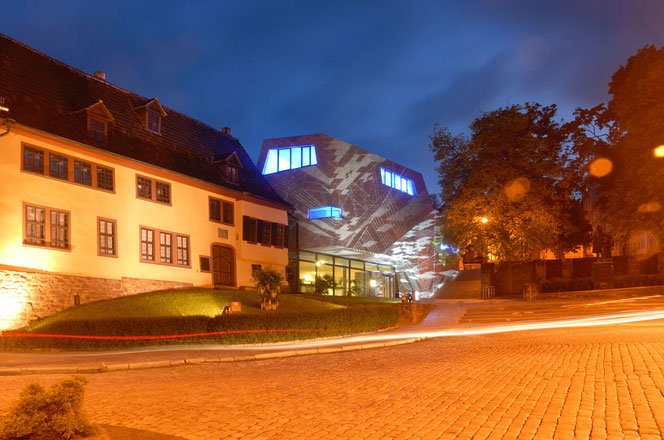
A catastrophe for photographers, if a destination is not only three hours away. You make a trip to a world-famous landmark and when you stand right in front of it, there is something that spoils your dream photo. Do you see Bach? Between the two trees.
The First Bach Calendar and Its January Page: Eisenach, Thuringia, Germany
Without question, Eisenach offers "the most Bach for time and money". Because besides the historical Bach House and the modern Bach Museum there is, of course, first and foremost one of the two most famous Bach monuments. Who doesn't know it, who is interested in Johann Sebastian Bach? Next, if you "invest" a few minutes for the city center: There the Georgenkirche (... St. George Church) is located and in it, you firstly find a dark, somber Bach monument, secondly the baptismal font in which Johann Sebastian Bach was baptized and thirdly one can read a line above the portal, which originally formed an ensemble with the meanwhile moved Bach monument. A little further "uphill" is the school which Bach and Martin Luther attended. No ... not, together, but 200 years, by the thumb, time-shifted. The fact that Johann Sebastian's father, Ambrosius was a city piper in the City Palace, doesn't really count, of course.
Photographing the ensemble of the Bach Museum, the Bach Monument and Bachhaus is a small challenge for a perfect photo. Because if you don't want to photograph without the sun on the "object of desire", you have to find out that this combination can only be photographed in summer, only with the best weather and only until 9:00 a.m.! It shouldn't be too early either, because then the light isn't perfect and there shouldn't be any clouds underway, because if a big, thick, fluffy one pushes itself in front of the sun at 8:30 a.m., then that was it with the dream photo.

Right, there is no sun shining on the Bachhaus. At that time we were only planning the perfect moment for a perfect photo.
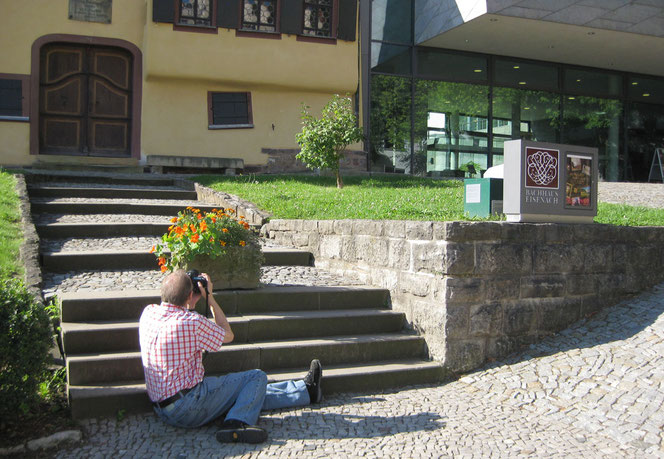
You should not have a dirt allergy, if you want to make photos from a cool perspective. Above this picture – by the way – is exactly the photo, which I photographed back then.
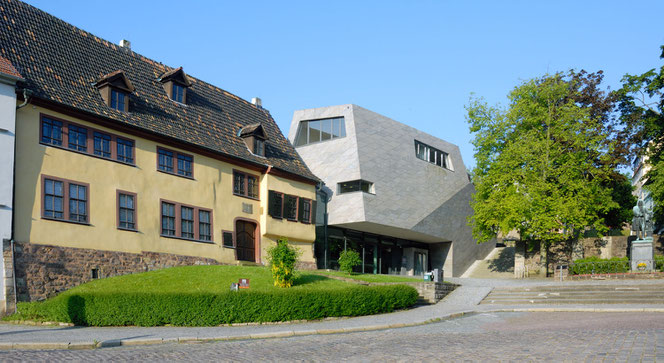
Yeah, there's only about a half-hour window. And that is in midsummer, because during the rest of the year, the sun does not shine on this trilogy. And before 8.30 a.m. it is too early, and after 9:00 a.m. it's just too late.
The First Bach Calendar and Its February Page: Ohrdruf, Thuringia, Germany
Next destination is Ohrdruf. The Bach memorial there for the Bach calendar. It took four trips until this cool and interesting Bach Memorial without Johann Sebastian Bach was "in the box", as we photographers say here in Germany. The first three visits there, Peter didn't know anything about this jewel. And – as he learned later – one or the other Ohrdruf resident did not either. But finally it was found. Quite modestly behind the tower of the no longer existing St. Michaelis Church. Inconspicuous, almost hidden. Maybe that's why there is a second one that honors the whole family of musicians besides Bach, but in particular the Ohrdruf branch. This second one is in the city park. But not in this Bach calendar.
Almost acrobatics were necessary to photograph the first above-mentioned Bach monument with the quotation from Beethoven: "He should be called Ocean, not Bach" from as low a position as possible. By the way, to get the quote above, Bach is the word for a "creek" in German. If you are a "good old-fashioned" photographer, like my husband, then you do it lying on your back, your head pressed to the ground. Later, back home, you work on the roof of the house behind it, renovate the steeple real quick and finally correct the crashing lines. And in almost no time you have the February motif for the Bach calendar.

Also, not in the Bach calendar: the second monument, which not only honors Johann Sebastian Bach, but in particular the Ohrdruf musicians in the famous Bach family.
The First Bach Calendar and Its March Page: Arnstadt, Thuringia, Germany
Arnstadt and the Bach monument number 3 on the March page of the Bach calendar. How do you get the beautiful city hall or at least its neighbor houses plus the Bach monument on one photo? You photograph Bach from his back. By the way, this Bach is best suited for group photos. He lounges for you in front of the town hall on the marketplace and is a refreshing alternative to the usual sculptures.
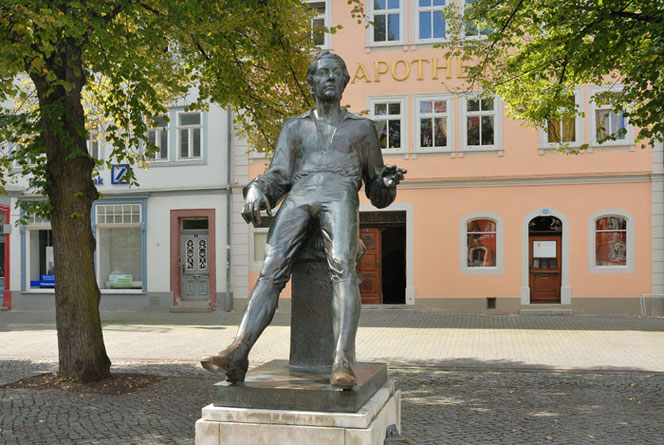
No. 3 of the motifs that did not make it into the Bach calendar. This is what the background looks like when you see Bach in Arnstadt from the front: It's not as exciting as with the dreamlike house backdrop on the other side.
The First Bach Calendar and Its April Page: Mühlhausen, Thuringia, Germany
Bach in Mühlhausen, Germany. Bach is too tiny and too close to the mighty St. Blasius Cathedral: You just can't get the composer on a picture with the church behind it. And he's also standing around in the shade, but that doesn't cause any problems with good software. My husband prefers monuments in the sun much more than small monuments made of dark material in the shade. But somehow he always gets it right. For our Bach calendar in April.

Not in the Bach calendar, position 4: Bach next ( ! ) to his pedestal in Mühlhausen, without getting down on your knees in front of him to take a cool photo.
The First Bach Calendar and Its May Page: Weimar, Thuringia, Germany
Weimar is so "overburdened" with culture that they afford to literally hide Johann Sebastian Bach, certainly the world's most famous celebrity. You can stand ten meters (... some 30 feet) away from him and almost overlook him. Perhaps there is just no better place available in Weimar. And the monument is small. Comparatively tiny. You can photograph it – like on the websites of my husband – in a way that it looks impressive. But there, however, it is inconspicuous, lost and at a sad location. However – so says my husband – you can remove the cobwebs from him so well and what else sticks to him if you come prepared with a cloth and some water. Simply only ... to take great photos. For the May sheet in the Bach calendar.
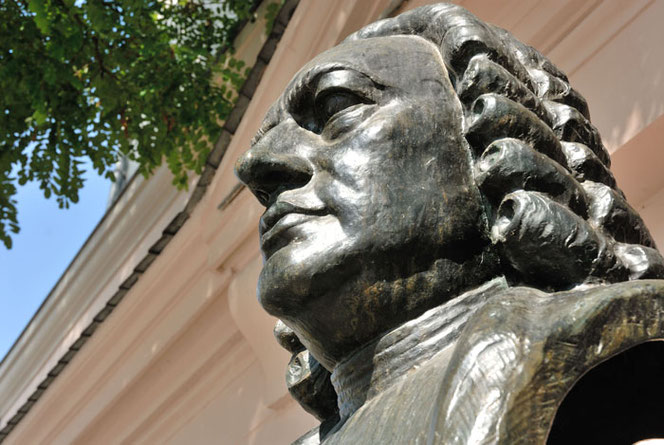
That is how he looks impressing (... however, the photo isn't in the Bach calendar) ...
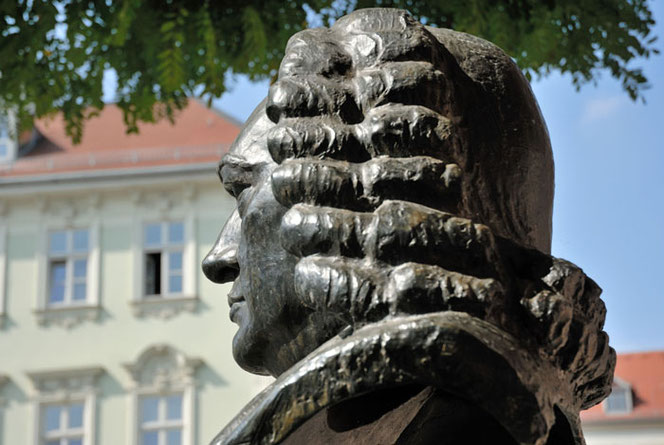
... that is, how he looks impressing, too (... plus this picture wasn't allowed into the Bach calendar) ...
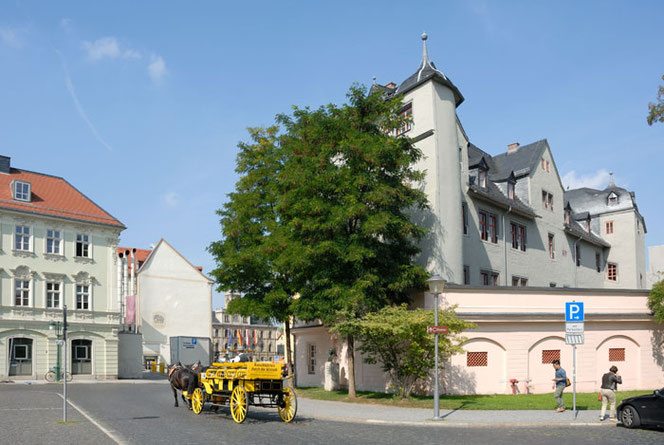
Do you recognize Bach's bleak little place? No, you don't? Okay, let's research together. You see the yellow cartridge, you can't miss it. On the right of the cartridge there are two trees. Between the two trunks is the left gray section a window, the right gray section "something" is Bach. Did I exaggerate? However, of course, the monument is allowed in the Bach calendar.
The First Bach Calendar and Its June Page: Köthen, Saxony-Anhalt, Germany
Köthen, the Bach city, where Johann Sebastian would have liked to stay all his life. Together with Maria Barbara, he had hoped for a great future. It turned out differently: Maria Barbara died, his friend Prince Leopold turned his back on music, and Bach left Köthen to become the Thomas Cantor in Leipzig, Saxony, Germany.
The memorial in Köthen has moved to today's Bachplatz (... Bach Square) and can be photographed there in such a way that the pretty sign, the master himself and also the second house in which Bach lived with his family in Köthen is immortalized in one picture. So, this Bach monument is on the June page of the Bach monuments calendar.

Köthen has dedicated Johann Sebastian Bach in an honorable place: in front of the second Bachhaus – the first no longer exists – on the Bachplatz. Many thanks to the city of Köthen. Now we know why Johann Sebastian Bach felt most comfortable in this city by far. This monument is a favorite in the Bach calendar.
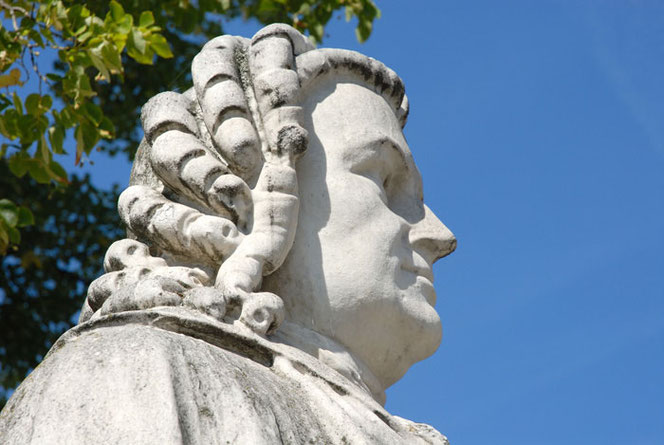
As a small, late thank-you to the city of Köthen, a second motif by Johann Sebastian is to be placed here in Köthen, so that you can admire Mr. Bach from very close. Nevertheless, in the Bach calendar there is of course only one page with the master in Köthen.
The First Bach Calendar and Its July Page: Leipzig (1), Saxony, Germany
You can read it somewhere: The Old Bach Monument in Leipzig is located in a green area on the Dittrichring. And anyone who has read it will hardly ever find it immediately. Because that's where it is, for sure. But if you had been told that it is only about 20 steps from the New Bach Monument, hundreds of tourists from all over the world would simply "take it with them" on their Bach trip. Two trips were necessary anyway, because what would be a great photo without sunshine, firstly, and without green leaves on the trees, secondly. By the way, this Bach monument is the world's first, donated, that is financed, by composer Felix Mendelssohn Bartholdy and for us, it is the July motif in the Bach calendar.
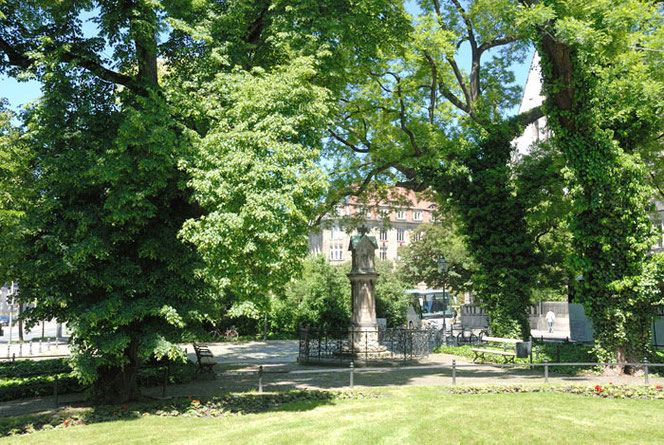
That is, how you can easily find the first Bach monument. Walk between the Thomasshop at the side of the Thomaskirche and the Bach Archive through this alley. As soon as the green area begins, you cannot miss Bach in it. Regarding the distance: If you lean at the Thomaskirche, you can hit the monument with a tennis ball. That is how close the first monument is located to the second monument. As the first Bach monument on earth, it must of course be included in the Bach calendar.
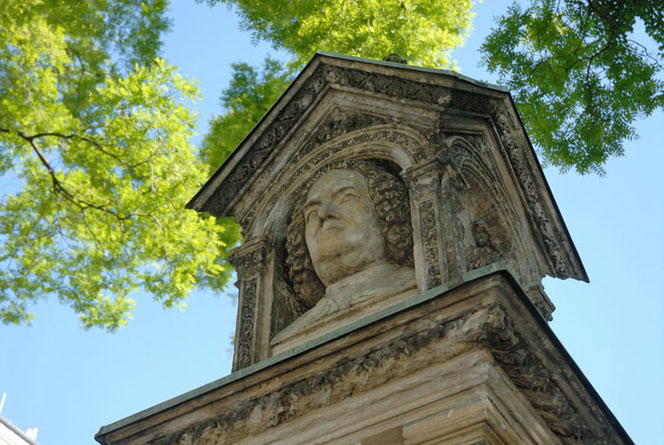
Honor, to whom honor belongs: the Old Bach Monument, closer. However, this picture didn't make it into the Bach calendar. Instead of that, another nice one.
The First Bach Calendar and Its August Page: Leipzig (2), Saxony, Germany
It is the most impressive Bach monument in the world, also certainly the largest and on the most prominent square. The pedestal already makes up a large part of the monument. It stands at the side of St. Thomas Church and attracts thousands every year to be on a photo with the great composer. Two or three trips help to find really good perspectives, to finally make the best photo among all the August calendar sheet. In the Bach calendar. By the way: The impressive city of Leipzig and tiny Ohrdruf are the two Bach locations that each have two Bach monuments.
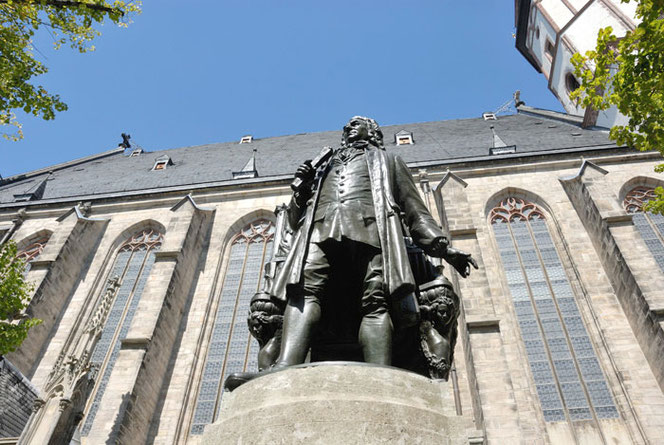
Which one into the Bach calendar? Out of the pictures from the most famous Bach monument (... of course it's only a little more famous than the Bach monument in Eisenach) it's possible without effort, to photography one dozen great pictures. It's just stupid: You just have to decide for one finally. So, here are three photos, which are not in the Bach calendar: the first of all ...
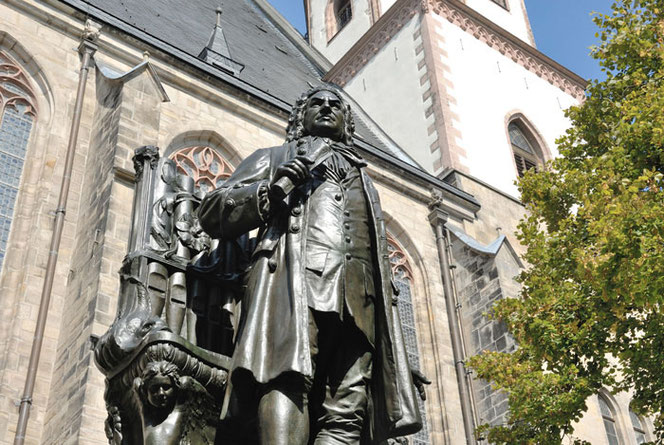
... not in the Bach calendar for the second ...
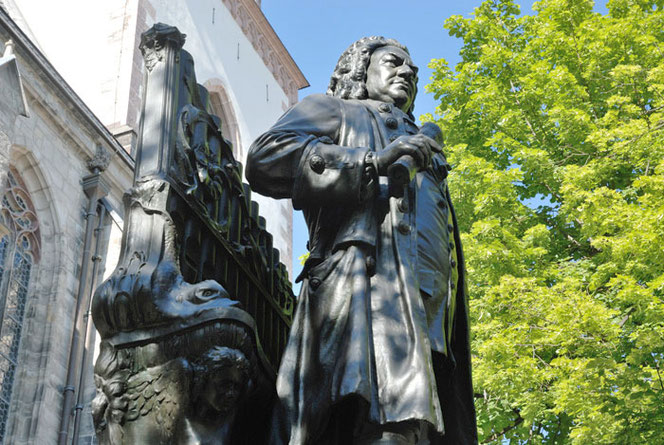
... and not in the Bach calendar for the third.
The First Bach Calendar and Its September Page: Paris, France
In fact, my husband and I went to Paris on a back then expected perfect sunny day for only two reasons. One was to find Bach at the Paris Opera. Secondly, we needed a cartoon of Johann Sebastian, the "primal work of art" of all today's paintings, drawings, etchings, engravings, oil paintings and cartoons that we have from Bach. And from the composers of classical music.
Bach at the opera was quickly found, and that the medal lay in the sun was pure luck. The time for a first attempt at photographing him perfectly was not quite so coincidental. If the sun is unfavorable at 9:00 a.m., there is usually a second chance at 3:00 p.m. Only very, very few motifs are located so unfavorable that the sun never shines on the desired side. Today it is the picture with the longest trip to finally "land" in the Bach calendar: a 1,200 kilometers round trip, which is 745 miles.
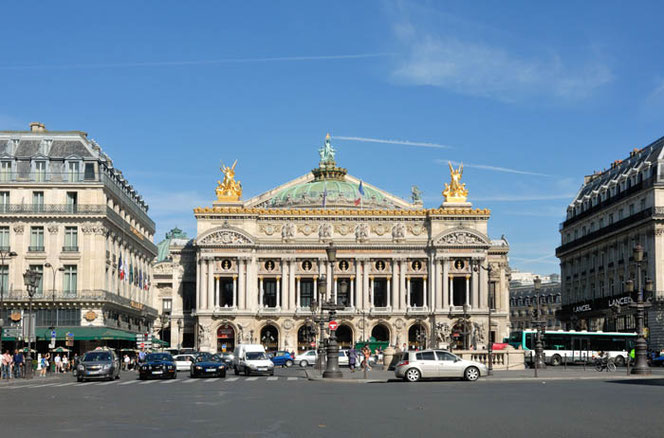
What does a photographer, who is excited by Bach hope, when he is approaching the Opéra in Paris, France? Do you know? He or she hopes, that Bach is in the sunshine at this building. If not, there is no place for this Bach monument in this Bach calendar.
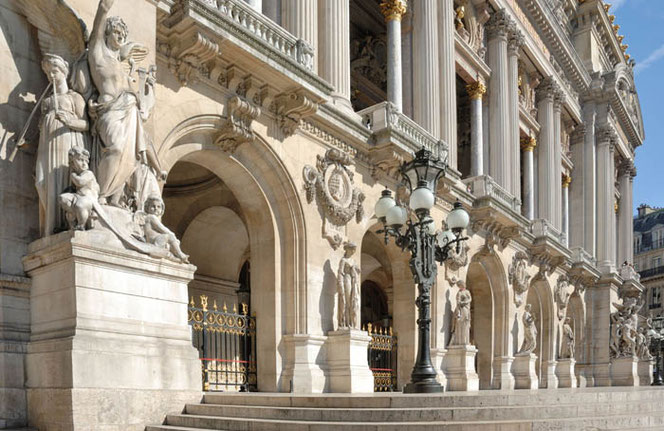
Bach closer ... but not in the Bach calendar ...
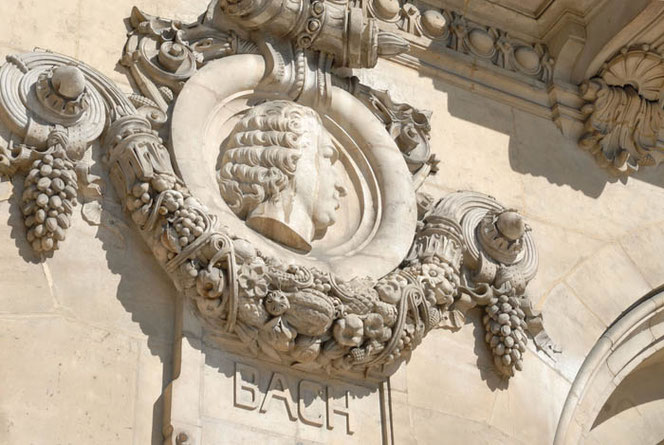
... Bach real close ... and also not in the Bach calendar.
The First Bach Calendar and Its October Page: Ansbach, Northern Bavaria, Germany
The Bach monument in Ansbach. It was, back then, almost the final one that my husband discovered and photographed. You're on the internet for hours if you're really looking for them: the Bach monuments in the world. And again and again, you find the ones you've already found. Only one single inconspicuous motif brought the reference to the Bach monument, which could practically not be found anywhere else on the internet at all. With a perfect weather forecast, my husband was able to photograph this Bach monument "almost from home": Ansbach is that close – comparatively – to Heilbronn.
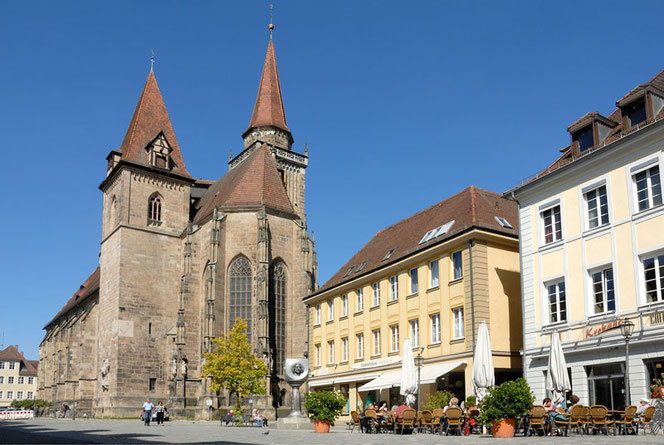
Here, Mr. Bach is located in Ansbach, Northern Bavaria, Germany. However, this picture would definitely not have been the perfect one for the Bach calendar.
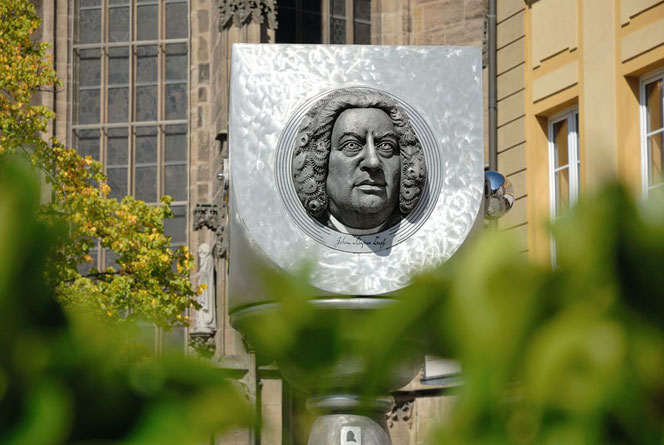
This photo would have been cool, too, but didn't make it into the Bach calendar.
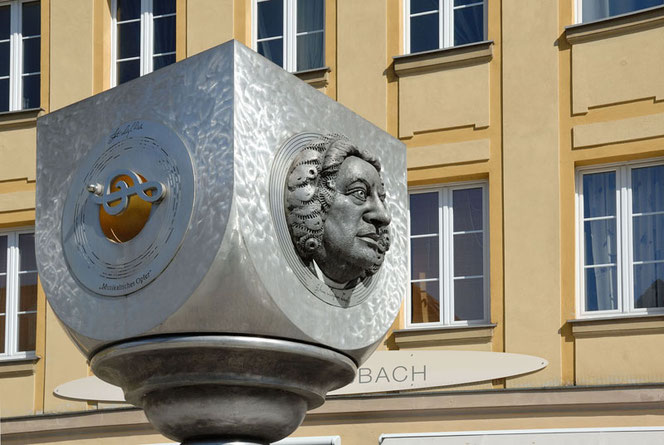
And that is the favorite motif of my husband: the Bach monument, with the lettering "Bach" in the background. All is a question of the perspective, is what he is saying. This motif, of course, is not so great that it was allowed into the Bach calendar.
The First Bach Calendar and Its November Page: Rothenburg on the Tauber, Northern Bavaria, Germany
You browse and browse for historical paintings, postcards, stamps, small pictures, etchings, oil paintings, miniatures, books, brochures, booklets and everything else there is: One of them was there. Namely, a so-called advertising stamp. A glass window in a church was depicted on it, including the words: Bachfenster in Rothenburg ob der Tauber. While searching for Bach cities and Bach places, a phone call quickly clarified that Bach had never been to Rothenburg, but that there was a Bach monument located. That is the window that was shown on the advertising stamp.
In the St. James's Church, behind the Blood Altar, according to cordial information of the local tourism priest, this window could be found in all its splendor. But while my husband was photographing it, he asked himself the only decisive question: How can you tell that the organist is Bach? You look at the surrounding pictures to see if there is a hint. And you recognize that it is not only one window connected to Bach, but an entire ensemble. And for this reason it simply had to be included in this Bach calendar. As the November motif.
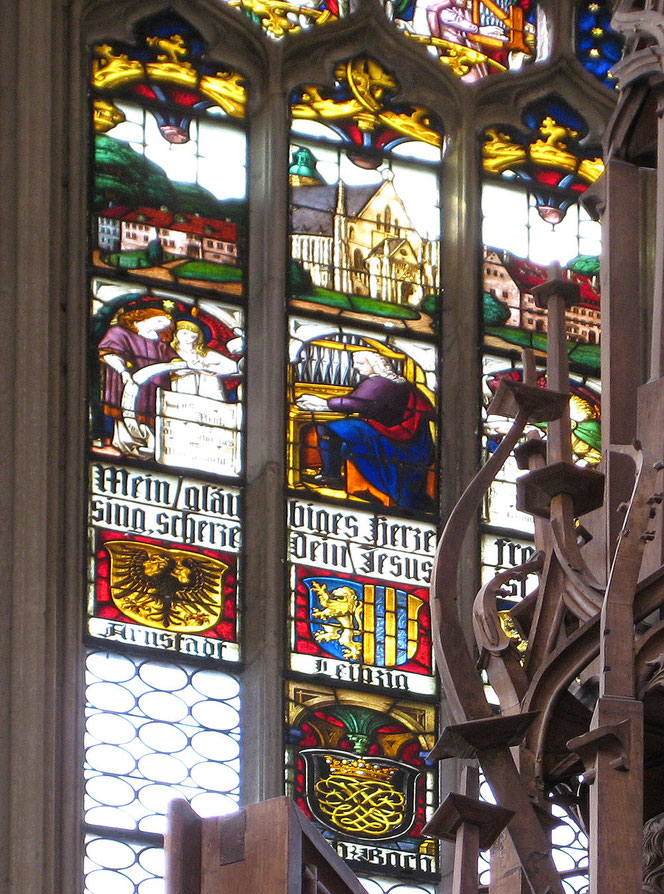
The Blood Altar (... marginally visible on the right in the picture) is the sensation in this church for thousands of tourists, for quite a few Bach fans it is also the Bach window ensemble. And every bet: Bach lovers, who came there because of the historic Rothenburg, wouldn't even notice it.
The First Bach Calendar and Its December Page: Ulm, Germany
Also, this Bach monument below could only be found once on the internet as a tiny picture, and it was one of the last Bach monuments that my husband discovered in order to compile it "collectively, so to speak" for those interested in Bach. My husband did not succeed in photographing it in the same way as the one motif he saw on the internet, that is with the sunshine on the monument. But for such a photo to succeed, it took a little more than perfect weather. It had to be a certain day of the year and the perfect time, plus cloudless weather. In order for the sun to shine through one of the church windows at the right angle to Bach, almost a study is necessary. And that ... is a real challenge even for a perfectionist who doesn't live in this city. Nevertheless, and in particular with the dreamlike background, it crowns the Bach calendar as the December motif.
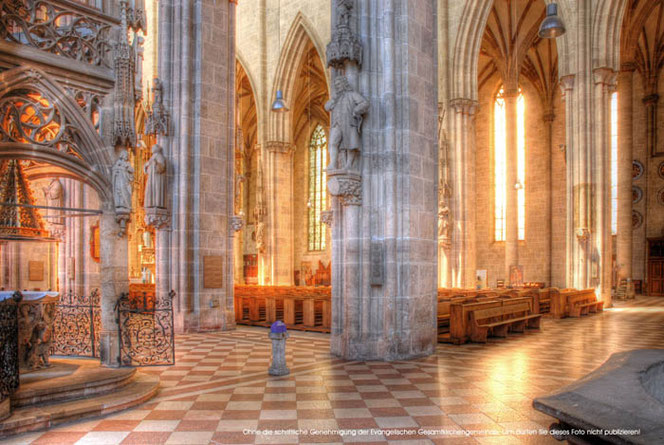
You now know meanwhile what Bach looks like closer in the Ulm Cathedral. Here you have a good impression of where the composer stands exactly. And why it is so difficult to photograph him in such a way that he is illuminated by the sunshine.
The First Bach Calendar and the Three Not Used Photos From Shanghai, Far Away, in China
How seriously was I looking for a great photo of this Bach monument, which is practically nowhere to be found on the internet? On the one hand I did not give up, because one day I wanted to afford the fun and have some cool photos taken by a photographer there, on a sunny day in spring, without any smog in the metropolis of Shanghai. In the meantime, however, I can proudly show you some excellent photos that I have been allowed to use until now. Thank you very much for that, Reinhard und Christiane Casper.

Do you see the park in the lower half on the left side? There is Bach. If you look very closely, you will see the pedestal of the Bach monument just above the cyclist behind the blue vehicle on the far left. And you can see the notes on the wall behind it. © (3) Info.
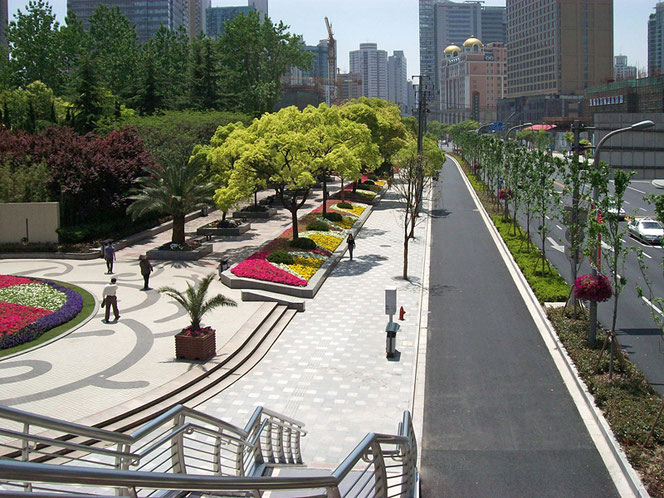
And here is the proof: Even in China, Bach is not "just somewhere", see the photo below ...
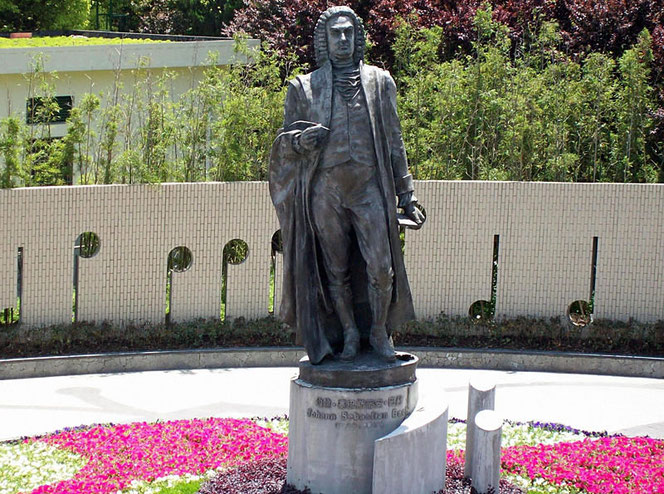
Mr. Bach in Shanghai, very close to the main station. It is written at the bottom of the pedestal. For the 1.4 billion in Chinese, for the rest of the world in English. Or is it even German? Actually ... this motif also belongs in our cool Bach calendar.
There Is More, Beyond Bach Calendars and More Bach Calendars: Four Exciting Examples ... Four Exciting Music Gift Ideas

The Bach figure: "Bach 4 You" specializes in this department.

Also, composers calendars are a specialty ... not only Bach calendars. Plus, music T-Shirts, composers T-shirts and Bach T-shirts.

Incredibly, you can promote the "Bach Mission" and our "Classical Music for Children" Mission even if you buy a gift from another vendor that isn't even a music gift. You can learn more about this with one click.
* incl. VAT; plus S&H
Renate Bach Publishing "Bach 4 You" – Bildstrasse 25, 74223 Flein / Germany – Phone: +49 7131 576761 – info (at) bach4you.de



